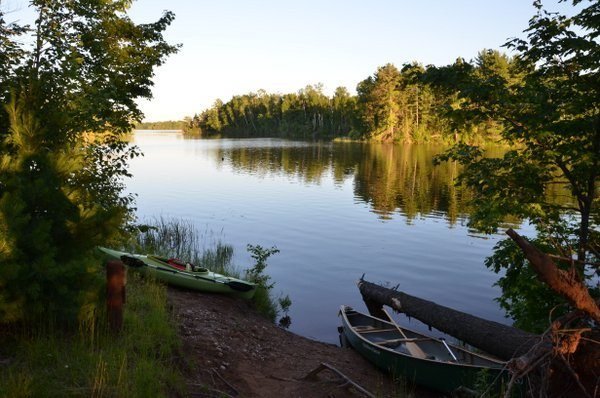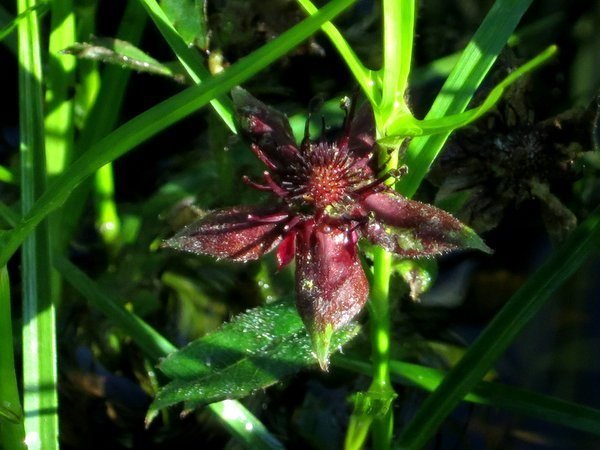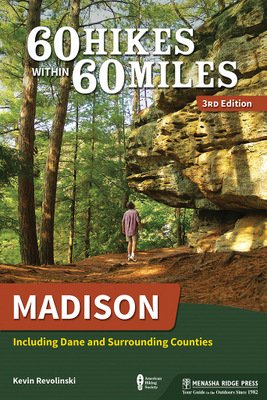Wisconsin’s Little Boundary Waters: Turtle-Flambeau Flowage
I am looking down on a waxing pre-dawn moon, clear and unshimmering in the waters off the edge of this private island. I’m sharing some Northwoods time with old buddies Rob and Dave on the annual paddle-up camping trip. The loons are going insane in the distance, nothing like the usual mournful call I expect. Frogs have set up a perimeter of croaking, and the birds have definitely set their internal alarm clocks in an effort to catch that proverbial worm.
But I never mind being awake this early on a camping trip. Mists have gathered along the opposite shore and drift out over that reflected lunar image which fades as the light gathers. The wisps drift like ghosts and disappear into the sunlight leaving me with a landscape Rorschach view of the forest.
See my latest book on Wisconsin Paddling!
While so many places offer solitude and communion with Mother Nature, it isn’t often you can find a place that is completely cut off from the human touch. There’s always a distant hum of highway, or a barely discernable call of a freight train miles away, or even the crunch of gravel as someone rolls late into the campground. Here the only chatter of a nearby campfire is the one right in front of me. The next site, which was empty last night – as they all appeared to be within at least a half mile when we arrived yesterday – isn’t even reachable on foot. I’d have to paddle there. And when the last of the infrequent bass trollers has headed back to the boat landing for the day, the only evidence of civilization is the occasional satellite threading its way mutely through the sprinkled lights of the Milky Way.
This is the Turtle-Flambeau Flowage, the new love of my outdoor life. Created when the Turtle Dam was built on the Flambeau River in 1926, it is a flooded lowland that erased 16 lakes from the map and created this reservoir for both flood protection and hydroelectric power. That’s its practical purpose, but the aesthetic result is a labyrinth of islands, wilderness, and sprawling waters.
I was told this is Wisconsin’s version of the Boundary Waters, and there are certainly enough similarities to make that claim. Most of Turtle-Flambeau is only accessible by water. At over one million acres with 2,000 campsites, the actual Boundary Waters Canoe Area Wilderness is a giant cousin; but a “diminutive” 19,000 acres of water, and nearly double that in protected wilderness, plus 210 miles of shoreline, are nothing to sneeze at either. Add to this Turtle-Flambeau’s accessibility – less than 20 minutes from either US-51 at Mercer or US-13 at Park Falls, and a distance of 275 and 375 miles from Minneapolis and Chicago, respectively – and you can see why someone might pass over the longer haul to the Minnesota-Ontario border. Plus, there is no permit necessary; you can come on the spur of the moment. Camping is free; not even a Wisconsin state park pass is required. While you still need to plan and pack carefully, you are not as far from the modern world as you will feel.
With the exception of a few sites one can pay to reserve, the rustic camping of the flowage is first come, first served. For the precision planners this might be a bit unnerving. You could potentially paddle for miles on a busy weekend in July before finding an open spot. But that’s part of the experience, and what makes this place so isolated even at peak times. The first to fill are the sites closest to one of the seven boat landings.
Rustic sites come with nothing more than a fire ring with a heavy retractable grill. The pit toilets don’t even have a shelter around them. You can almost miss the small wooden box with a toilet seat on it, hidden in the trees and brush a short walk from each site. Family sites only add a picnic table, often a bulky construction of cut logs. There is no drinking water, so you either pack it in or bring a water filter suitable for lake water.
Twenty minutes from shore, we saw our first loon. Ten minutes later, the first bald eagle, circling right above us before the wind took pushed the soaring circle to the south. We make camp on a small wooded island in the Voluntary Quiet Zone, an area representing one-fifth of the flowage, and set about gathering firewood for the evening.
The next day is given to exploration. We paddle into the Manitowish River, a major supplier to the flowage. The water level is high, thanks to abundant rain, and on another excursion we manage to negotiate an area marked “non-navigable” on the map. When we paddle free of the soup of lake water, lily pads and tall grass, we find another huge expanse of blue. On the map this is a whole other major portion of flowage; it was once two much smaller lakes separated by forest.
The return to our campsite is over four miles the long way around, but to add a bit of the Boundary Waters experience we opt for a portage just a mile away. The 1,000-foot crossing on a trail often hidden by an understory of ferns puts us back in the Quiet Zone, one cove over from our tent.
We’ve only got three nights on the water, not enough to cover even one fold of the map, but we break camp and set off in search of another site farther west, closer to the dam. In the wide open stretch a strong westerly wind kicks up waves enough to make me realize conditions on a rough day could be enough to delay departure for smaller craft such as my recreational kayak. Sea kayaks or stable canoes are the way to go.
We also pass the damage from a 2010 tornado, the snapped trunks of trees a reminder that Mother Nature’s in charge here and you’re not just a few steps from shelter. Cutting through a narrow channel to get shelter from the wind, we come to an island with a tiny clearing at one point and spot the numbered wooden post of an open campsite. We paddle up and stake our claim.
Dave ventures off for a couple hours in the kayak to see the dam while Rob and I idle with books at the breezy southern point of our new island. Dave portaged over to the Flambeau – a very nice option for those who prefer to paddle with current – and circled an island under the dam. For a moment he was visited by otters. We watched a deer and two fawns far across the water, then a mother grebe and her ten babies, which were already testing their underwater swimming distance before popping up and making a made surface paddle for mom.
Bird species here number over 150. Bear and wolves are rare but not unheard of. If you’re really lucky, you might even see a moose in the fall. You’re virtually guaranteed the company of eagles and loons. Depending on where you paddle, however, you might not see another human.
See a Turtle-Flambeau Flowage photo gallery on my blog
Tips for Camping Turtle-Flambeau Flowage:
 Have a backup plan if you are coming during a busy time. If you can’t find a site on the flowage, there is an abundance of nearby “mainland” camping, including Lake of the Woods County Park and sites in Chequamegon-Nicolet National Forest.
Have a backup plan if you are coming during a busy time. If you can’t find a site on the flowage, there is an abundance of nearby “mainland” camping, including Lake of the Woods County Park and sites in Chequamegon-Nicolet National Forest.
A compass or GPS can prevent you from getting turned around among the many islands and channels. There is a GPS-coordinate map on the DNR’s website.
Keeping food tightly locked up and even hung from a tree will keep raccoons, red squirrels, and the rare bear from joining you for dinner.
Tell someone staying behind your plan and how long you’ll be gone.
Cell phone connection can be hit or miss and, if calling for an emergency, GPS data is helpful. Bring a radio to listen for National Weather Service warnings.
For more information, go to the flowage’s website or call the Department of Natural Resources office in Mercer at (715) 476-7846.














 ORDER YOUR COPY TODAY!
ORDER YOUR COPY TODAY! ORDER YOUR COPY TODAY!
ORDER YOUR COPY TODAY!
Love your photos, especially the flowers and the sunset.
Pingback: Canoe Camping on the St. Croix and Namekagon Rivers - The Mad Traveler
I lived on the Flowage and I truly miss it.